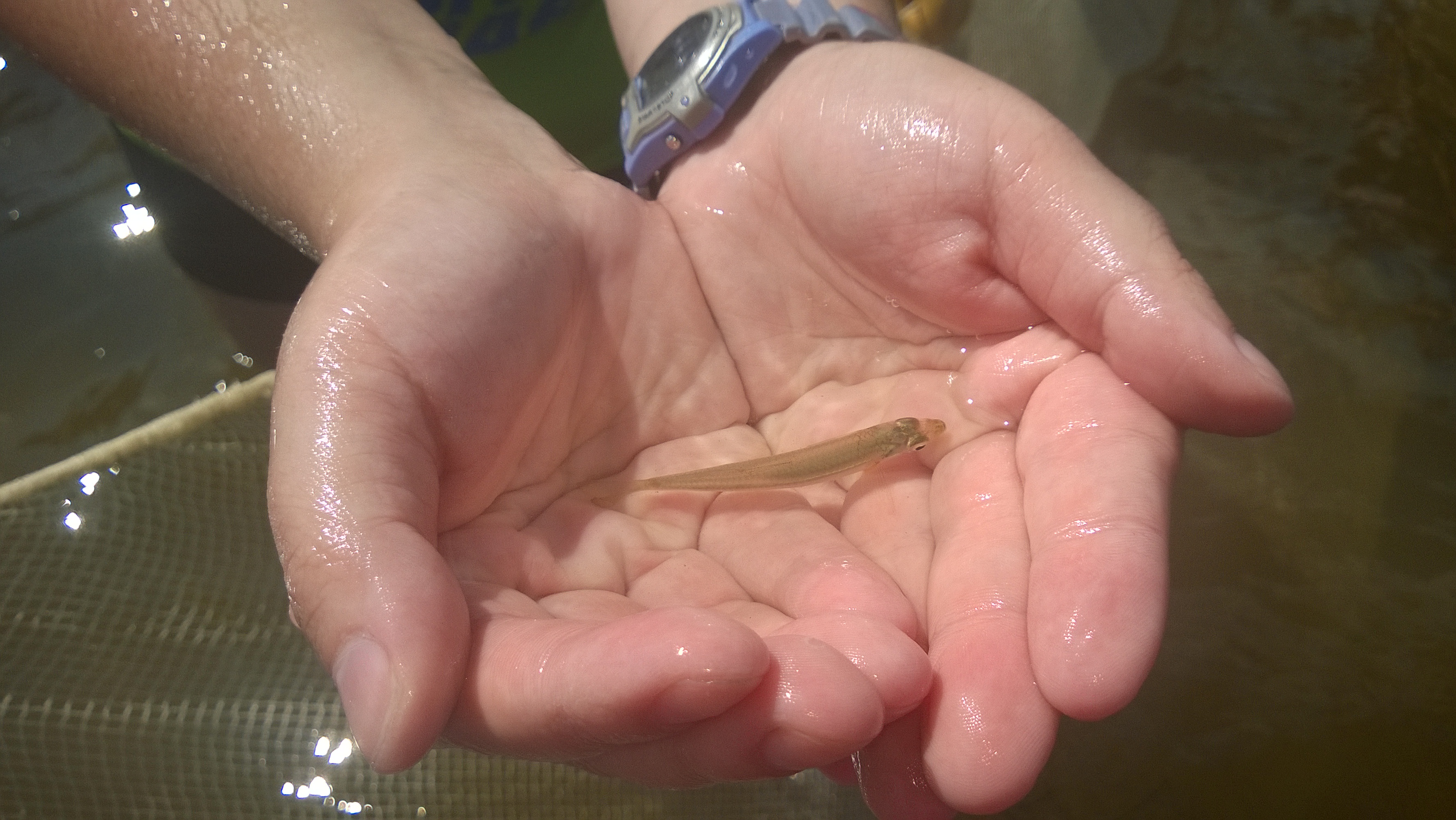
by Laura Tiu | May 12, 2018
Are you interested in learning about marine life, going fishing, or exploring the underwater world with a mask and snorkel? If so, this is the camp for you! This local education opportunity for budding marine scientists will be happening this summer at Camp Timpoochee in Niceville, FL. The camps enable participants to explore the marine and aquatic ecosystems of Northwest Florida; especially that of the Choctawhatchee Bay. Campers get to experience Florida’s marine environment through fishing, boating snorkeling, games, STEM (science, technology, engineering & math) activities and other outdoor adventures. University of Florida Sea Grant Marine Agents and State 4-H Staff partner to provide hands-on activities exploring and understanding the coastal environment.

Sampling the benthic community at Timpoochee.
Florida Sea Grant has a long history of supporting environmental education for youth and adults to help them become better stewards of the coastal zone. This is accomplished by providing awareness of how our actions affect the health of our watersheds, oceans and coasts and marine camp is a great opportunity for sharing that information. Many of the Sea Grant youth activities use curriculum developed by the national Sea Grant program and geared toward increasing student competency in math, science, chemistry and biology. The curriculum is fun and interesting!
Marine Camp is open to 4-H members and non 4-H members between the ages of 8-13 (Junior Camp) and, new this year, ages 14-17 (Senior Camp). There will be two Junior Camps in 2018. The July 23-27 camp is full, but there are still openings for the June 25-29 session. The cost for Junior Marine Camp is $275.00 for the week. A more intensive Senior Marine Camp has been scheduled for July 16-20. This camp will contain a community service component and costs $300 for the week.
If Marine Camp sounds interesting to someone you know, visit the Camp Timpoochee website at http://florida4h.org/camps_/specialty-camps/marine/ for the 2018 dates and registration instructions. A daily snack from the canteen and a summer camp T-shirt are included in the camp fees, along with three nutritious meals per day prepared on site by our certified food safety staff. All cabins are air-conditioned. So many surprises await at marine camp, come join the fun.
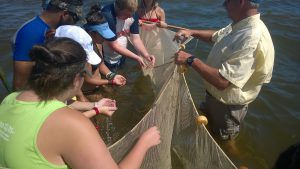
Seining the sea grass at Timpoochee.
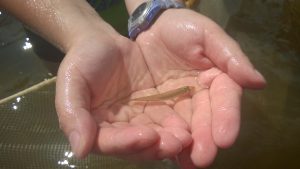
Larval fish in the Timpoochee oyster reef.

by Rick O'Connor | Jan 19, 2018
In the last article, we discussed what phytoplankton are, what their needs were, and their importance to marine life throughout the Gulf and coastal estuaries. In this article, we will discuss the different types of phytoplankton found in our waters.
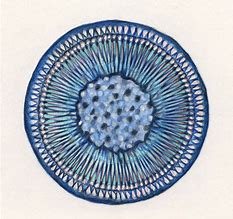
The spherical shape of the centric diatom.
Image: Florida International University
Marine scientists interested in the diversity and abundance of phytoplankton will typically sample using a plankton net. There are a variety of different shapes and sizes of these nets, but the basic design would be funnel shaped with a sample jar attached at the small end of the funnel. The plankton net would be towed behind the research vessel at varying depths for a set period of time. All plankton collected would be analyzed via a microscope. According to the text Identifying Marine Phytoplankton (1997) there are at least 14,000 species of phytoplankton and some suggest as many as 120,000. Most of these, 12,000-100,000, are diatoms, one of five classes of marine phytoplankton. The majority of the phytoplankton fall into one of two class, the diatoms and the dinoflagellates.
Diatoms are typically single celled algae encased in a clear silica shell called a frustule. The frustule can come in a variety of shapes, with or without spines, and many resemble snowflakes – their quite beautiful. They are found in the bay and Gulf in great numbers, as many as 40,000,000 cells / cup of seawater. They are the dominate phytoplankton in colder waters and are most abundant near upwellings. These are the “grasses of the sea” and the base of many marine food webs. When diatoms die, their silica shells sink to the seafloor forming layers of diatomaceous earth, which is used in filters for aquariums and oxygen mask in hospitals.
Dinoflagellates differ from diatoms in that they produce two flagella, small hair-like projections from the algae that are used for generating water currents and movement. Their shells are not silica but layers of membranes and are called thecas. Some membranes are empty and others contain different types of polysaccharides. Dinoflagellates are more abundant than diatoms in warmer waters. There are about 2000 species of them. One type, Noctiluca, are responsible for what locals call “phosphorus” or bioluminescence. These dinoflagellates produce a blue-ish light when disturbed. Many see this when walking the beach at night. Their footprints glow for a few seconds. At night, boaters can see this as their prop wash turns the dinoflagellates in the water column. The bioluminescence is more pronounced in the warm summer months and is believed to be defense against predation. The light is referred to as “cool” light in that the majority of the energy is used in producing light, not lost as heat as with typical incandescent bulbs – hence the birth of the LED light industry.
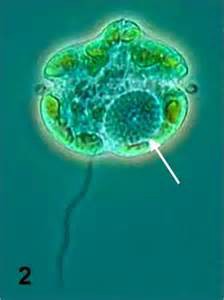
The dinoflagellate Karenia brevis.
Photo: Smithsonian Marine Station-Ft. Pierce FL
Several dinoflagellates produce toxins as a defense. Some generate what we call red tides. In the Gulf of Mexico, Karenia brevis is the species most responsible for red tide. Red tides typical form offshore and are blown into coastal areas via wind and currents. They are common off the coast of southwest Florida but occur occasionally in the panhandle. Many local red tides are actually formed in southwest Florida and pushed northward via currents. Red tides are known to kill marine mammals and fish, as well as closing areas for shellfish harvesting.
Like true plants, phytoplankton conduct photosynthesis. Between the diatoms and dinoflagellates, 50% of the planet’s oxygen is produced. These are truly important players in the ecology of both the open Gulf and local bays.
References
Annett, A.L., D.S. Carson, X. Crosta, A. Clarke, R.S. Ganeshram. 2010. Seasonal Progression of Diatom
Assemblages in Surface Waters of Ryder Bay, Antarctica. Polar Biology vol 33. Pp. 13-29.
Hasle, G.R., E.E. Syvertsen. 1997. Identifying Marine Phytoplankton. Academic Press Harcourt Brace and
Company. San Diego CA. edited by C.R. Tomas. Pp. 858.
Steidinger, K.A., K. Tangen. 1997. Identifying Marine Phytoplankton. Academic Press Harcourt Brace and
Company. San Diego CA. edited by C.R. Tomas. Pp. 858.
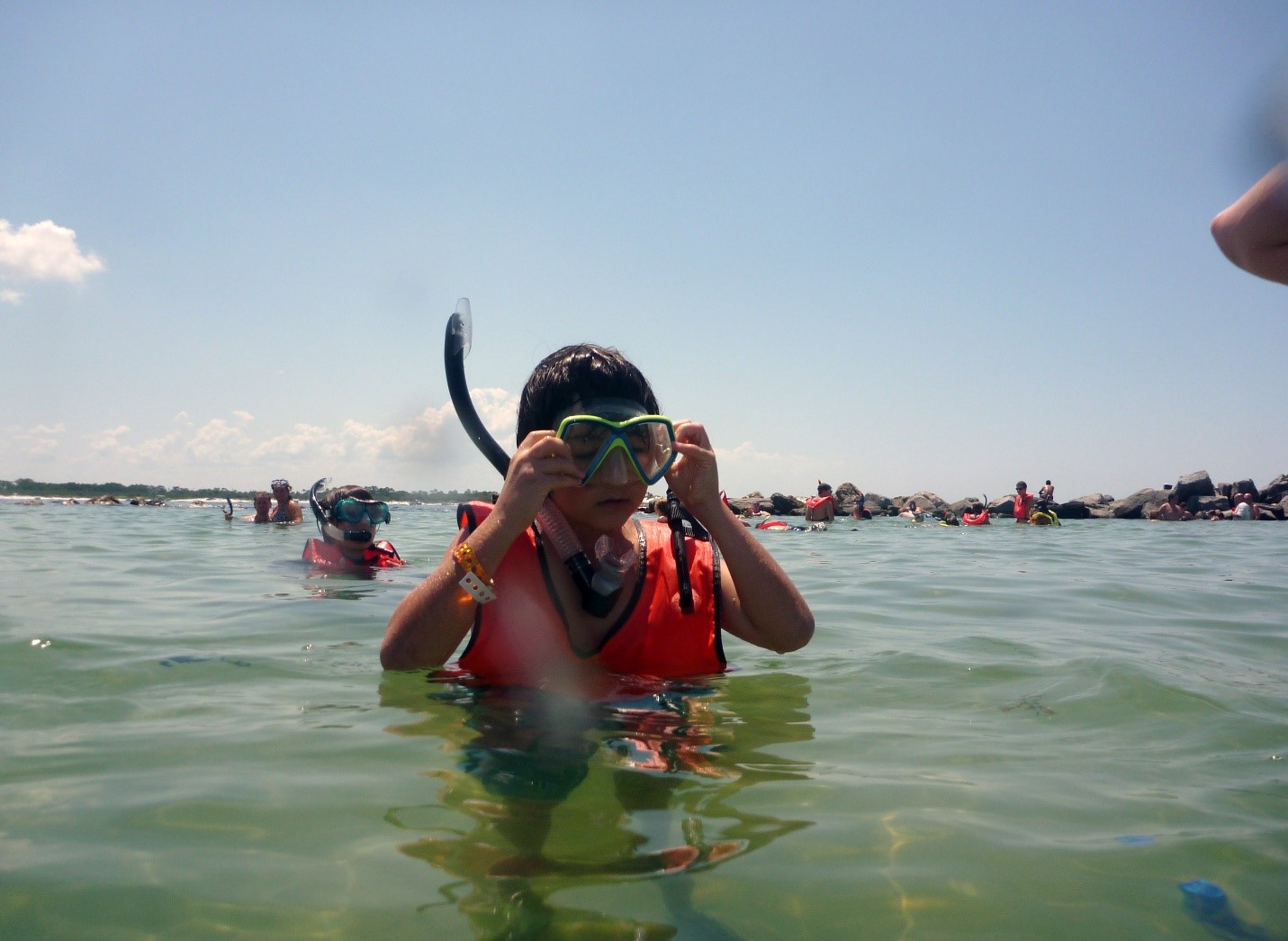
by Scott Jackson | Jul 14, 2017
The St Andrew Bay pass jetty is more like a close family friend than a collection of granite boulders. The rocks protect the inlet ensuring the vital connections of commerce and recreation. One of the treasured spots along the jetty is known locally as the “kiddie pool”, which is accessible from St Andrew’s State Park. There are similar snorkeling opportunities throughout northwest Florida. Jetties provide an opportunity to explore hard substrate or rocky marine ecosystems. These rocks are home to a variety of colorful sub-tropical and migrating tropical fish.
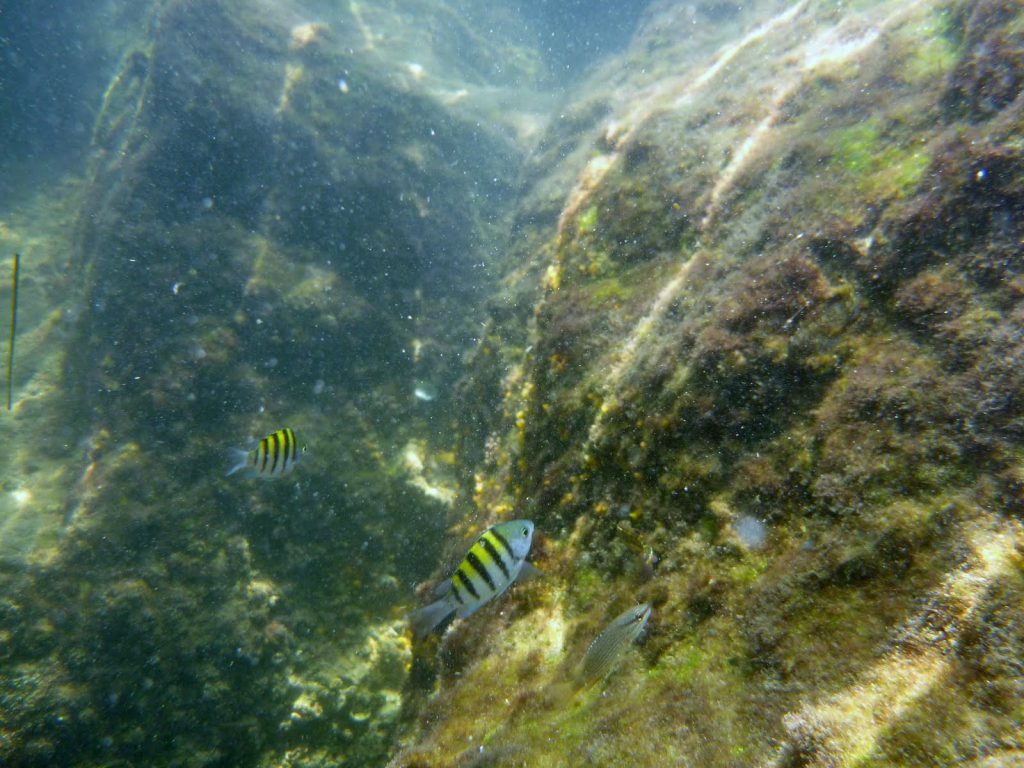
Snorkelers and divers who visit are likely to see a variety fish like sergeant majors, blennies, surgeon and doctor fish, just to name a few. Photo by L Scott Jackson.
Exploring a jetty is more like a sea-safari adventure than an experience in a real swimming pool – it is a natural place full of potential challenges that first time visitors need to prepare to encounter.
Divers and snorkelers are required to carry dive flags when venturing beyond designated swimming areas. These flags notify boaters that people are in the water. Brightly colored snorkel vests are not only good safety gear but they help you rest in the water without standing on rocks which are covered in barnacles and sometimes spiny sea urchins.
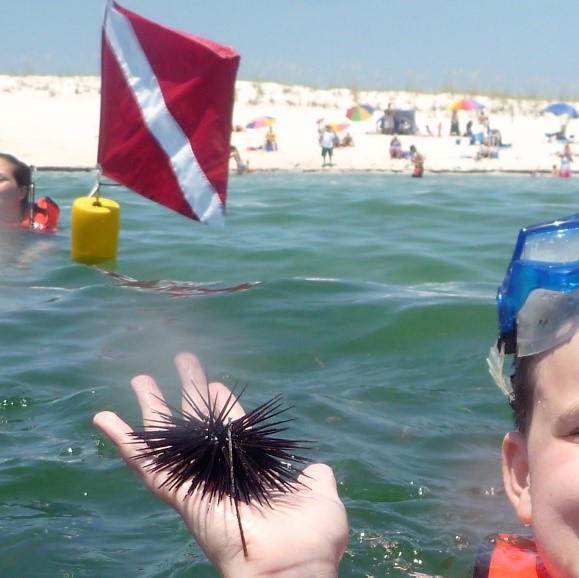
According to the Florida Department of Health, most sea urchin species are not toxic but some Florida species like the Long Spined Sea Urchin have sharp spines can cause puncture injuries and have venom that can cause some stinging. Swim and step carefully when snorkeling as they usually are attached to rocks, both on the bottom and along jetty ledges. Photo by L Scott Jackson
Dive booties also help protect your feet. I found out the hard way! A couple of years ago my foot hit against a sea urchin puncturing my heel. The open back of my dive fin did not provide any protection resulting in a trip to the urgent care doctor. My daughter later teased it was an “urchin care” doctor! Sea urchin spines are brittle and difficult to remove, even for a doctor. Lesson Learned: “Prevention is the best medicine”.
After a couple of weeks of limping around and a course of antibiotics, I recovered ready to return one of my favorite watery places – a little wiser and more prepared. I now bring a small first aid kit, just in-case, to help take care of small scrapes, cuts, and other minor injuries.
Gloves are recommended to protect hands from barnacle cuts and scrapes. Shirts like a surfing rash guard or those made from soft material help keep your body temperature warm on long snorkel excursions. Along with sunscreen, shirts also protect against sunburn.
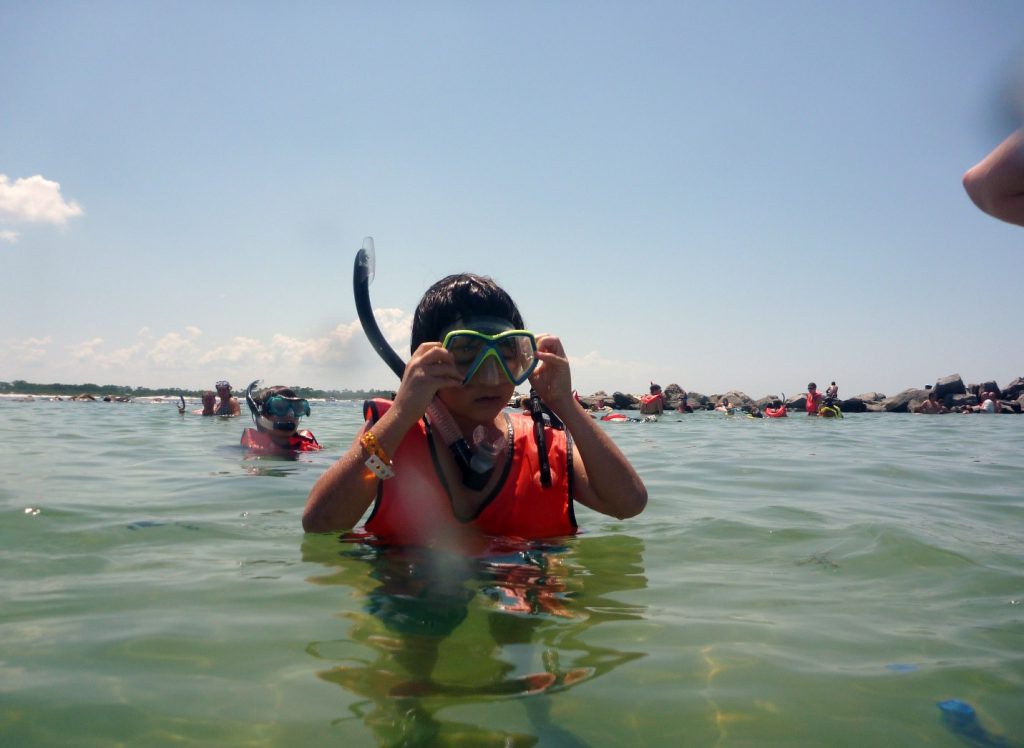
There’s opportunity to see marine life from the time you enter the water with depths for beginning snorkelers at just a few feet deep. Some SCUBA divers also use the jetty for their initial training. Most underwater explorers are instantly hooked, and return for many years to come. Photo by L Scott Jackson
Finally, know the swimming abilities of yourself and your guests, especially when venturing to deeper areas. It’s good to have a dive buddy even when snorkeling. Pair up and watch out for each other. Be aware that currents and seas can change dramatically during the day. Know and obey the flag system. Double Red Flag means no entry into the water. Purple flags indicate presence of dangerous marine life like jellyfish, rays, and rarely even sharks. Local lifeguards and other beach authorities can provide specific details and up to date safety information.
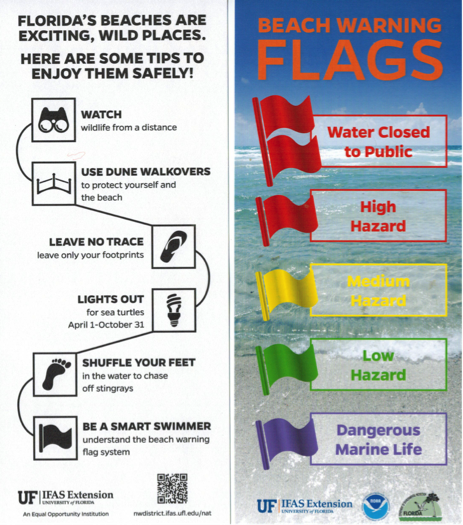
Follow these beach safety tips for helping your family enjoy the beach while protecting coastal wildlife.
An Equal Opportunity Institution. UF/IFAS Extension, University of Florida, Institute of Food and Agricultural Sciences, Nick T. Place, dean for UF/IFAS Extension. Single copies of UF/IFAS Extension publications (excluding 4-H and youth publications) are available free to Florida residents from county UF/IFAS Extension offices.

by Laura Tiu | Jun 3, 2017
There are five species of sea turtles that nest from May through October on Florida beaches. The loggerhead, the green turtle and the leatherback all nest regularly in the Panhandle, with the loggerhead being the most frequent visitor. Two other species, the hawksbill and Kemp’s Ridley nest infrequently. All five species are listed as either threatened or endangered under the Endangered Species Act.
Due to their threatened and endangered status, the Fish and Wildlife Conservation Commission/Fish and Wildlife Research Institute monitors sea turtle nesting activity on an annual basis. They conduct surveys using a network of permit holders specially trained to collect this type of information. Managers then use the results to identify important nesting sites, provide enhanced protection and minimize the impacts of human activities.
Statewide, approximately 215 beaches are surveyed annually, representing about 825 miles. From 2011 to 2015, an average of 106,625 sea turtle nests (all species combined) were recorded annually on these monitored beaches. This is not a true reflection of all of the sea turtle nests each year in Florida, as it doesn’t cover every beach, but it gives a good indication of nesting trends and distribution of species.
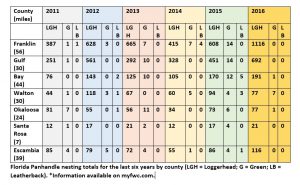 If you want to see a sea turtle in the Florida Panhandle, please visit one of the state-permitted captive sea turtle facilities listed below, admission fees may be charged. Please call the number listed for more information.
If you want to see a sea turtle in the Florida Panhandle, please visit one of the state-permitted captive sea turtle facilities listed below, admission fees may be charged. Please call the number listed for more information.
- Gulf Specimen Marine Laboratory, 222 Clark Dr, Panacea, FL 32346 850-984-5297 Admission Fee
- Gulf World Marine Park, 15412 Front Beach Rd, Panama City, FL 32413 850-234-5271 Admission Fee
- Gulfarium Marine Adventure Park, 1010 Miracle Strip Parkway SE, Fort Walton Beach, FL 32548 850-243-9046 or 800-247-8575 Admission Fee
- Navarre Beach Sea Turtle Center, 8740 Gulf Blvd, Navarre, FL 32566 850-499-6774
To watch a female loggerhead turtle nest on the beach, please join a permitted public turtle watch. During sea turtle nesting season, The Emerald Coast CVB/Okaloosa County Tourist Development Council offers Nighttime Educational Beach Walks. The walks are part of an effort to protect the sea turtle populations along the Emerald Coast, increase ecotourism in the area and provide additional family-friendly activities. For more information or to sign up, please email ECTurtleWatch@gmail.com. An event page may also be found on the Emerald Coast CVB’s Facebook page: facebook.com/FloridasEmeraldCoast.
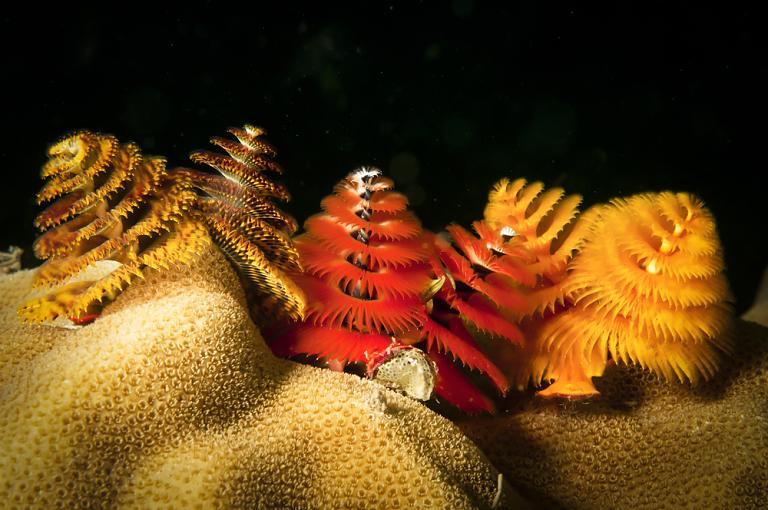
by Chris Verlinde | Dec 19, 2016
The holiday season is a special time for most of us! There are many creatures that live under the sea that represent many of our holiday traditions.
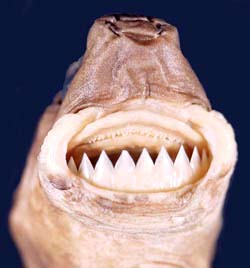
Photo Credit: Fl. Museum Of Natural History, George Burgess
Small cookie cutter sharks are found in very deep water during the day, at night they migrate up the water column to feed. Cookie cutter sharks attract their prey with lighted photophores. Photophores are lighted organs located on the lower part of the shark. Small fish are attached to the glow, larger fish searching for prey get close enough to the shark and the shark bites the prey. The cookie cutter shark has specialized sucking lips that attach to the victim. The shark then spins its body around and leaves a cookie cutter shaped hole in the fish.
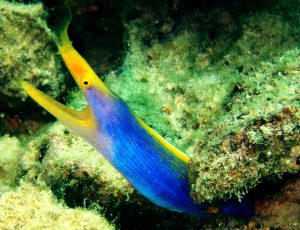
Photo credit: Wikimedia Commons
Ribbon Eels are found in the Indio Pacific. They have long slender bodies and move like ribbons in and through the crevices reefs. They eat live fish. To view a YouTube video of ribbon fish feeding, click here.

Photo credit: Chris Verlinde
Jingle shells get their name as a result of their shells that when shaken together make a jingle like sound. Jingle shells can be found along the beaches of NW Florida. The shiny iridescent shell is strong and very attractive. Many shell collectors use the shells to make jewelry and wind chimes.
Jingle shells are bivalves and live attached to hard surfaces, just like oysters.
Jingle shells are filter feeders, meaning water is filtered through their gills for plankton.
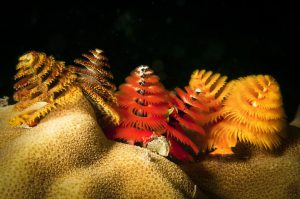
Photo credit: Wikimedia commons
Christmas tree worms are Christmas tree shaped worms that form burrows corals. The tentacles, which form the tree-like structures are used for feeding on plankton and to breathe. These plumed creatures are a type of polychaete worm.
Christmas tree worms come in many colors and can be found all over the world. They feed by using their feathery appendages, called radioles to capture phytoplankton that floats by the “feathers.”
Christmas tree worms are easily disturbed and will quickly vanish into their burrows as shadows or larger marine life pass by. They return quickly and continue with their sedimentary lifestyles in the coral.

“Marine snow” falls gently on to a coral-covered shipwreck explored in the Gulf of Mexico in 2012 by the NOAA Ship Okeanos Explorer. Photo Credit NOAA
Marine snow gets its name as a result of the fluffy materials that resemble snow falling from the sky. Marine snow is decaying material from plants and animals that have died in the oceans. Marine snow may also include sand, fecal matter and inorganic dust.
Just like snowflakes, marine snow grows as it floats to the ocean depths. Marine snow is consumed by scavengers that live along the deep-sea floor bottom. Check out the video below showing the beauty of marine snow.
There are many more festive creatures that live in the sea. Have a wonderful Holiday Season!
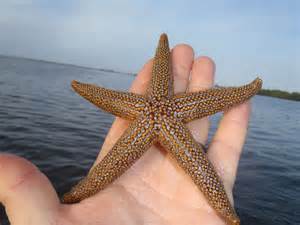
by Rick O'Connor | Dec 16, 2016
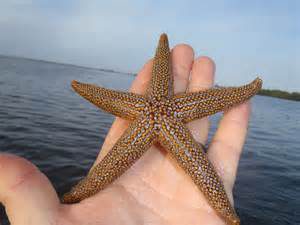
The Florida Orange Sea Star.
Photo: Florida Sea Grant
One of the more popular traditions this time of year is placing the star on top of the Christmas Tree. The star represents the Christmas Star which led the wise men to the manager. The stars that have been placed on Christmas Trees over the decades have come in all shapes and forms but gulf coast residents will use a starfish to both represent the Nativity and their connection to the sea.
Starfish, more correctly called sea stars, are one of the most recognized marine creatures in the world. Many have used it as a logo or their symbol of the sea. But what is a sea star actually? We know they live on the bottom and look like stars but what do they do? How do they function?
Sea stars are invertebrates in the Phylum Echinodermata. Echinoderms have radial symmetry; meaning they have a distinct top and bottom but no head or tail. You certainly know if it is upside down but you are not sure if it is facing you. They are the only invertebrates to have an internal skeleton; called a test. It is this skeleton we find in the curio shops and stores – and what we place on our tree. This skeleton produces tubercules or spines which extend into (and above) the skin – giving them the “spiny skin” for which they get their name – “echino” “derm”. Echinoderms have a series of tube like sacs underneath their bodies which they fill with water and use like suction cups to move and feed. Most have male and females and all produce planktonic larva.
Sea stars in particular are found worldwide and are more common in coastal waters. They come in a variety of colors and most have five arms – though one species has 40! Their mouth is on the underside of the body and lacks teeth. They have a pigment spot at the end of each arm that can detect light. Some sea stars are attracted to light, while others are repelled by it. Most sea stars are carnivorous, feeding on a variety of invertebrates including other echinoderms, and some are scavengers. Mollusk are a common prey, and – to the dismay of oyster farmers – oysters are an easy prey. The sea stars approach the bivalve, use their tube feet to open the two shells slightly, and insert their digestive tract inside the oyster. They attack the abductor muscle first, release the tension on the two shells, and then consume the rest of the animal. Sea stars like seawater, so oysters growing in the upper estuaries have fewer problems with these predators. Our local sea stars are good at detecting buried prey in our quartz sand and then digging them out. These animals are famous for their ability to regenerate their body parts. Oyster farmers trying to reduce this threat have been known to cut them and toss them back, only to have more sea stars later. However sexual reproduction is also very common. Most sea stars have 2 gonads per arm and can fertilize up to 2 million eggs in a spawning event. Spawning is usually in the spring and is triggered by chemicals in the water.
Though they are a classic icon for the ocean, and holiday decoration along the coast, these are fascinating animals in their own right. I wish all of you Happy Holidays and a joyous new year.






















